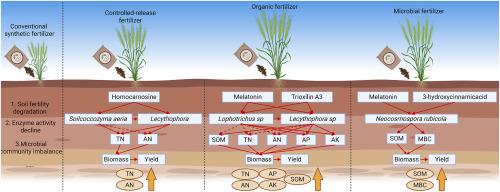Metabolite-driven fungal recruitment in rhizosphere explains superiority of organic fertilizer in enhancing the soil fertility of wheat
IF 8.4
引用次数: 0
Abstract
Long-term application of conventional synthetic fertilizers (CF) significantly impairs soil fertility, particularly in the intensive wheat/maize rotation systems. The problem is even worse in medium-low yield farmlands such as lime concretion black soil, resulting in an inevitable threat to world's food security. Therefore, adopting innovative alternatives becomes an urgent need to improve soil fertility and fulfill agricultural high yield demands and sustainable development. Thus, we conducted a two-year field experiment in lime concretion black soil to compare the divergent effects of controlled-release (CRF), organic (OF) and microbial (MF) fertilizers on soil fertility improvement under wheat cultivation. Combined analysis using Linear discriminant analysis effect size, Orthogonal Partial Least Squares Discriminant Analysis, and Structural Equation Modeling revealed that CRF improved soil nitrogen retention via homocarnosine-mediated recruitment of the fungi Solicoccozyma aeria and Lecythophora. Specifically, CRF increased total nitrogen and alkali-hydrolyzable nitrogen by 17.3 % and 11.8 % compared to CF, respectively. Interestingly, OF demonstrated the most comprehensive improvement in soil fertility. OF enhanced multiple soil fertility by enriching Melatonin and Trioxilin A3, which facilitated the recruitment of Lophotrichus sp. and Lecythophora sp. This led to significant increases relative to CF in soil organic matter (18.3 %), total nitrogen (13.8 %), alkali-hydrolyzable nitrogen (10.0 %), available phosphorus (17.2 %), and available potassium (29.0 %). In contrast, MF promoted carbon accumulation by enriching melatonin and 3-hydroxycinnamic acid, recruiting Neocosmospora rubicola, which resulted in a 5.15 % increase in soil organic matter and an 11.4 % rise in microbial biomass carbon compared to CF. These findings demonstrate that novel fertilizers enhance soil fertility through metabolite-mediated recruitment of functional fungi rather than bacteria, with OF exhibiting the greatest synergistic effect between the rhizosphere metabolome and fungal assemblage. This study lays a theoretical foundation for tailored strategies that simultaneously enhance agricultural productivity and sustainability in lime concretion black soil regions under wheat/maize rotation systems.

代谢物驱动真菌在根际的招募解释了有机肥在提高小麦土壤肥力方面的优势
长期施用常规合成肥料会显著损害土壤肥力,特别是在集约小麦/玉米轮作系统中。在石灰固结黑土等中低产农田,这一问题更为严重,对世界粮食安全造成不可避免的威胁。因此,采用创新替代方案是提高土壤肥力,实现农业高产和可持续发展的迫切需要。为此,我们在石灰固结黑土上进行了为期两年的田间试验,比较了控释肥(CRF)、有机肥(of)和微生物肥(MF)对小麦栽培土壤肥力的不同影响。利用线性判别分析效应大小、正交偏最小二乘判别分析和结构方程建模的综合分析表明,CRF通过高芥子酸介导的空气中前球菌和Lecythophora的招募,提高了土壤氮素的保留。具体而言,与CF相比,CRF使总氮和碱水解氮分别增加了17.3%和11.8%。有趣的是,有机肥对土壤肥力的改善最为全面。有机肥通过富集褪黑素和Trioxilin A3提高了土壤肥力,促进了Lophotrichus sp.和Lecythophora sp.的吸收,导致土壤有机质(18.3%)、总氮(13.8%)、碱解氮(10.0%)、有效磷(17.2%)和有效钾(29.0%)相对CF显著增加。相比之下,MF通过增加褪黑激素和3-羟基肉桂酸来促进碳积累,招募rubicola新宇宙孢子菌,导致土壤有机质增加5.15%,微生物生物量碳比CF增加11.4%。这些发现表明,新型肥料通过代谢物介导的功能性真菌而不是细菌的招募来提高土壤肥力。其中,OF在根际代谢组和真菌组合之间表现出最大的协同效应。本研究为在小麦/玉米轮作制度下同时提高石灰固结黑土地区农业生产力和可持续性的定制策略奠定了理论基础。
本文章由计算机程序翻译,如有差异,请以英文原文为准。
求助全文
约1分钟内获得全文
求助全文

 求助内容:
求助内容: 应助结果提醒方式:
应助结果提醒方式:


